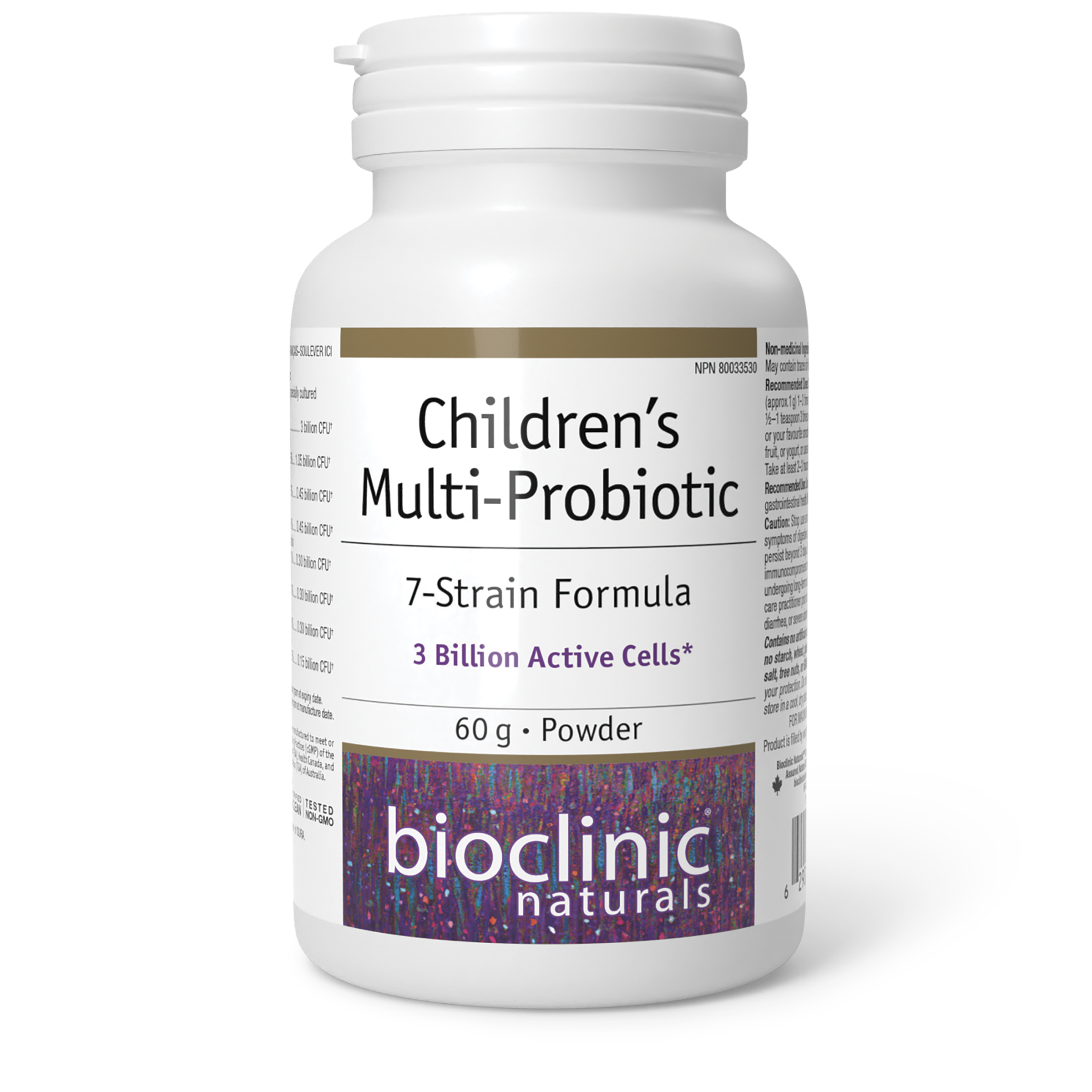
7 strain formula
3 Billion Active Cells
60 g ( SKU: 9460, NPN: 80033530 )
Benefits
- Contains a probiotic blend of seven species of Lactobacillus and Bifidobacterium, which are associated with a healthy gut microbiome during childhood
- Provides a guaranteed minimum of 3 billion active cells per serving
- Powder allows for easy dosing and convenience of mixing in other food/drinks
- No added flavours, colours, or sugar; gluten-free
Feature Summary
Children's Multi-Probiotic provides a clinical dose of seven probiotic Lactobacillus and Bifidobacterium species associated with healthy gastrointestinal function and the natural microbiome established during childhood. A healthy microbiota has been linked to a broad range of beneficial functions, including modulation of the immune system, increased response to vaccination, improved health of the cells lining the gastrointestinal tract and the GI barrier, and resistance to pathogenic bacterial species.1 Many of the beneficial effects of healthy microbiota have been attributed to their metabolites, such as short-chain fatty acids (SCFAs) and bile acids, which have both local and systemic effects.2
The species in Children’s Multi-Probiotic have been shown to have a number of specific benefits. For example, Bifidobacterium longum subspecies infantis has been described as a “champion colonizer of the infant gut,” linked to decreased inflammation and greater vaccine response. In addition, multiple strains in Children’s Multi-Probiotic have been associated with reduced inflammation when given to preterm infants.3,4 A meta-analysis suggests that Lactobacillus fermentum may be the most effective species for reducing the severity of atopic dermatitis in children. Similarly, multiple species of Lactobacillus and Bifidobacterium, particularly L. casei, reduce the risk for developing C. difficile-associated diarrhea following antibiotic use.5–7 Several large meta-analyses have also found a significant reduction in respiratory tract infections among children supplemented with probiotics.8,9
Medicinal Ingredients
| Each Gram (½ Teaspoon) Contains: | ||
| 3 billion active cells* of the following specially cultured strains of probiotics: | ||
| Total Bacterial Culture | 3 billion CFU† | |
| Lactobacillus rhamnosus (HA-111) (whole cell) |
35% | 1.05 billion CFU† |
| Bifidobacterium bifidum (HA-132) (whole cell) |
15% | 0.45 billion CFU† |
| Bifidobacterium breve (HA-129) (whole cell) |
15% | 0.45 billion CFU† |
| Bifidobacterium longum subsp. infantis (HA-116) (whole cell) |
10% | 0.30 billion CFU† |
| Lactobacillus acidophilus (HA-122) (whole cell) |
10% | 0.30 billion CFU† |
| Lactobacillus casei (HA-108) (whole cell) |
10% | 0.30 billion CFU† |
| Lactobacillus fermentum (HA-179) (whole cell) |
5% | 0.15 billion CFU† |
| †CFU: colony forming units | ||
| *Guaranteed minimum 3 billion active cells per gram at expiry date. | ||
| *Guaranteed minimum 5 billion active cells per gram at manufacture date. | ||
Non-Medicinal Ingredients
Maltodextrin, silica, ascorbic acid.
Dosage:
Recommended Dose: Children 1–5 Years Old: ½ teaspoon (approx.1 g) 1–3 times per day. Children 6–12 Years Old: ½–1 teaspoon 3 times per day. Can be mixed with water, juice, or your favourite smoothie, or sprinkled onto foods like cereal, fruit, or yogurt, or use as directed by a health care practitioner. Take at least 2–3 hours before or after antibiotics.
Warnings:
Stop use and consult a health care practitioner if symptoms of digestive upset (e.g., diarrhea) occur, worsen, or persist beyond 3 days. Do not use this product if you have an immunocompromised condition (e.g., AIDS, lymphoma, patients undergoing long-term corticosteroid treatment). Consult a health care practitioner prior to use if you have fever, vomiting, bloody diarrhea, or severe abdominal pain. Keep out of reach of children.
Allergens:
Contains no artificial colours, preservatives, or sweeteners; no starch, wheat, gluten, yeast, corn, egg, fish, shellfish, salt, tree nuts, or GMOs. Suitable for vegetarians. Sealed for your protection. Do not use if seal is broken. For freshness, store in a cool, dry place.
Contraindications
Consult a health care practitioner for use with cardiac valvular disease and short-gut syndrome.10
Drug Interactions
No known drug interactions; should be separated from antibiotic use by at least 2 hours.
- Sanders, M.E., Merenstein, D.J., Reid, G., et al. (2019). Probiotics and prebiotics in intestinal health and disease: From biology to the clinic. Nat Rev Gastroenterol Hepatol, 16(10), 605-16.
- Yoon, J.H., Do, J.S., Velankanni, P., et al. (2023). Gut microbial metabolites on host immune responses in health and disease. Immune Netw, 23(1), e6.
- Underwood, M.A., German, J.B., Lebrilla, C.B., et al. (2015). Bifidobacterium longum subspecies infantis: Champion colonizer of the infant gut. Pediatr Res, 77(1-2), 229-35.
- Brown, B.E., Huisman, E., Miller, M.R., et al. (2022). Enteral supplementation with probiotics in preterm infants: A retrospective cohort study and 6-year follow-up. Front Nutr, 9, 1063121.
- Fijan, S., Kolč, N., Hrašovec, M., et al. (2023). Single-strain probiotic Lactobacilli for the treatment of atopic dermatitis in children: A systematic review and meta-analysis. Pharmaceutics, 15(4), 1256.
- Ma, Y., Yang, J.Y., Peng, X., et al. (2020). Which probiotic has the best effect on preventing Clostridium difficile-associated diarrhea? A systematic review and network meta-analysis. J Dig Dis, 21(2), 69-80.
- Goldenberg, J.Z., Yap, C., Lytvyn, L., et al. (2017). Probiotics for the prevention of Clostridium difficile-associated diarrhea in adults and children. Cochrane Database Syst Rev, 12(12), CD006095.
- Wang, Y., Li, X., Ge, T., et al. (2016). Probiotics for prevention and treatment of respiratory tract infections in children: A systematic review and meta-analysis of randomized controlled trials. Medicine, 95(31), e4509.
- Zhao, Y., Dong, B.R., & Hao, Q. (2022). Probiotics for preventing acute upper respiratory tract infections. Cochrane Database Syst Rev, 8(8), CD006895.
- García-Santos, J.A., Nieto-Ruiz, A., García-Ricobaraza, M., et al. (2023). Impact of probiotics on the prevention and treatment of gastrointestinal diseases in the pediatric population. Int J Mol Sci, 24(11), 9427.
